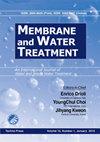Thermo-responsive antifouling study of commercial PolyCera® membranes for POME treatment
IF 0.8
4区 工程技术
Q4 ENGINEERING, CHEMICAL
引用次数: 2
Abstract
Membrane fouling is the main drawback of membrane technology. Frequent membrane cleaning and membrane replacement are, therefore, required to reduce membrane fouling that causes permeate flux reduction, lower rejection, or higher operating pressure. Studies have proved that the alteration of membrane properties is the key controlling factor in lessening membrane fouling. Among stimuli-responsive membranes, thermo-responsive membrane is the most popular, with a drastic phase transition and swelling-shrinking behavior caused by the temperature change. In this study, the thermo-responsive ability of two commercial membranes, PolyCera® Titan membrane and PolyCera® Hydro membrane, at different temperatures was studied on the antifouling function of the membrane in palm oil mill effluent (POME) treatment. The evaluation of the membrane's thermo-responsive ability was done through three cycles of adsorption (fouling) and desorption (defouling) processes in a membrane filtration process. The experimental result depicted that PolyCera® Hydro membrane had a higher membrane permeability of 67.869 L/m².h.bar than PolyCera® Titan membrane at 46.011 L/m².h.bar. However, the high membrane permeability of PolyCera® Hydro membrane was compensated with low removal efficiency. PolyCera® Titan membrane with a smaller mean pore size had better rejection performance than PolyCera® Hydro membrane for all tested parameters. On the other hand, PolyCera® Titan membrane had a better hydrodynamic cleaning efficiency than PolyCera® Hydro membrane regardless of the hydrodynamic cleaning temperature. The best hydrodynamic cleaning performed by PolyCera® Titan membrane was at 35°C with the flux recovery ratio (FRR) of 99.17 ± 1.43%. The excellent thermo-responsive properties of the PolyCera® Titan membrane could eventually reduce the frequency of membrane replacement and lessen the use of chemicals for membrane cleaning. This outstanding exploration helps to provide a solution to the chemical industry and membrane technology bottleneck, which is the membrane fouling, thus reducing the operating cost incurred by the membrane fouling.用于聚甲醛处理的商用PolyCera®膜的热响应防污研究
膜污染是膜技术的主要缺点。因此,需要经常清洗和更换膜,以减少膜污染,从而降低渗透通量,降低排斥或提高操作压力。研究表明,膜性质的改变是减少膜污染的关键控制因素。在刺激响应膜中,热响应膜是最常见的,它具有剧烈的相变和由温度变化引起的胀缩行为。在本研究中,研究了两种商用膜PolyCera®Titan膜和PolyCera®Hydro膜在不同温度下的热响应能力,研究了膜在处理棕榈油厂废水(POME)中的防污功能。通过膜过滤过程中的吸附(结垢)和解吸(除污)三个循环来评价膜的热响应能力。实验结果表明,PolyCera®Hydro膜具有较高的膜透性,为67.869 L/m².h。比PolyCera®Titan膜在46.011 L/m².h bar。然而,PolyCera®Hydro膜的高透性与低去除效率相补偿。在所有测试参数中,PolyCera®Titan膜的平均孔径比PolyCera®Hydro膜小,具有更好的过滤性能。另一方面,无论水动力清洗温度如何,PolyCera®Titan膜的水动力清洗效率都优于PolyCera®Hydro膜。PolyCera®Titan膜的最佳水动力清洗温度为35℃,通量回收率为99.17±1.43%。PolyCera®Titan膜优异的热响应特性最终可以减少更换膜的频率,减少化学物质在膜清洗中的使用。这一突出的探索有助于为化工行业和膜技术瓶颈——膜污染提供解决方案,从而降低膜污染带来的运行成本。
本文章由计算机程序翻译,如有差异,请以英文原文为准。
求助全文
约1分钟内获得全文
求助全文
来源期刊

Membrane Water Treatment
ENGINEERING, CHEMICAL-WATER RESOURCES
CiteScore
1.90
自引率
30.00%
发文量
0
审稿时长
>12 weeks
期刊介绍:
The Membrane and Water Treatment(MWT), An International Journal, aims at opening an access to the valuable source of technical information and providing an excellent publication channel for the global community of researchers in Membrane and Water Treatment related area. Specific emphasis of the journal may include but not limited to; the engineering and scientific aspects of understanding the basic mechanisms and applying membranes for water and waste water treatment, such as transport phenomena, surface characteristics, fouling, scaling, desalination, membrane bioreactors, water reuse, and system optimization.
 求助内容:
求助内容: 应助结果提醒方式:
应助结果提醒方式:


